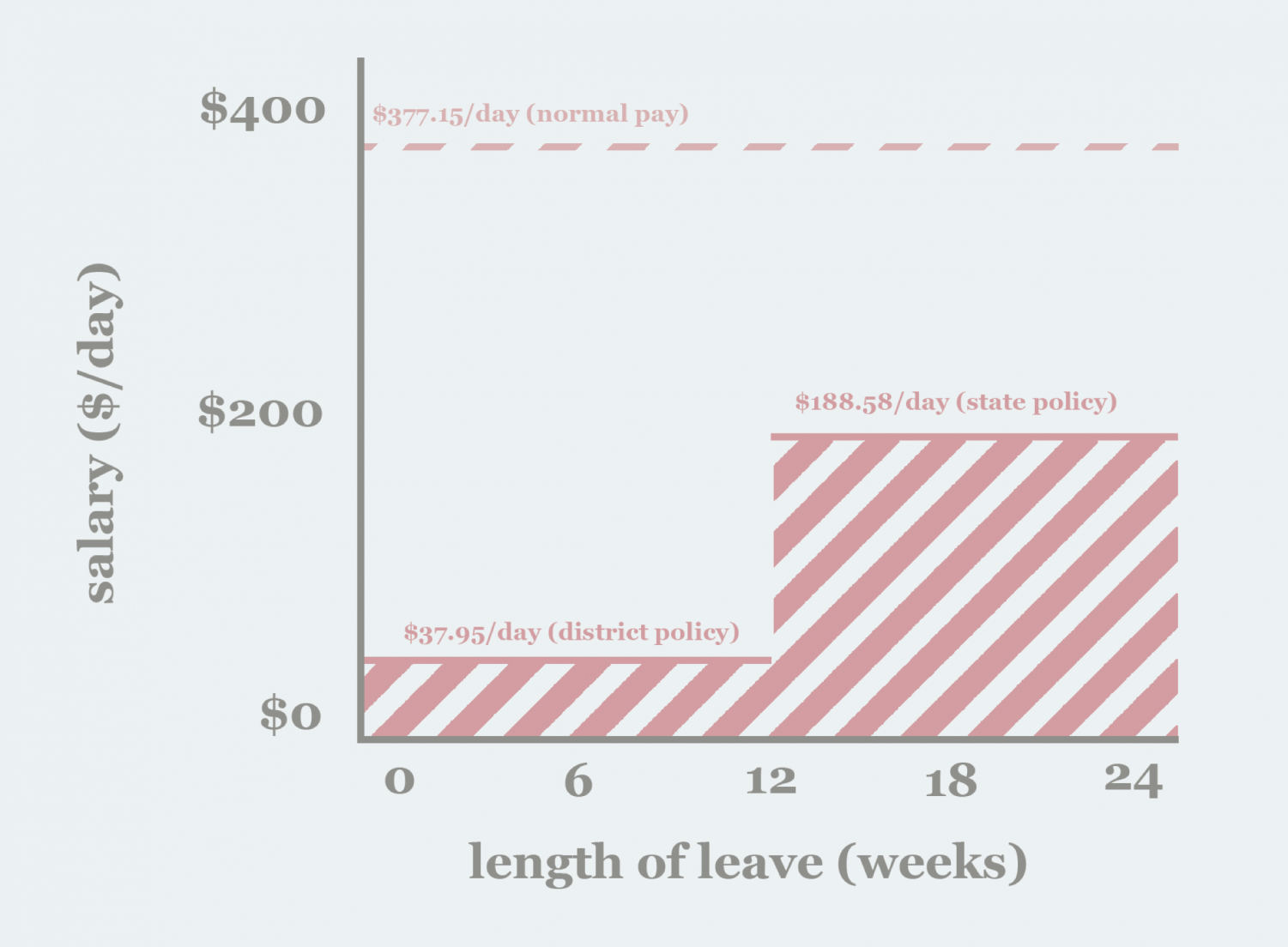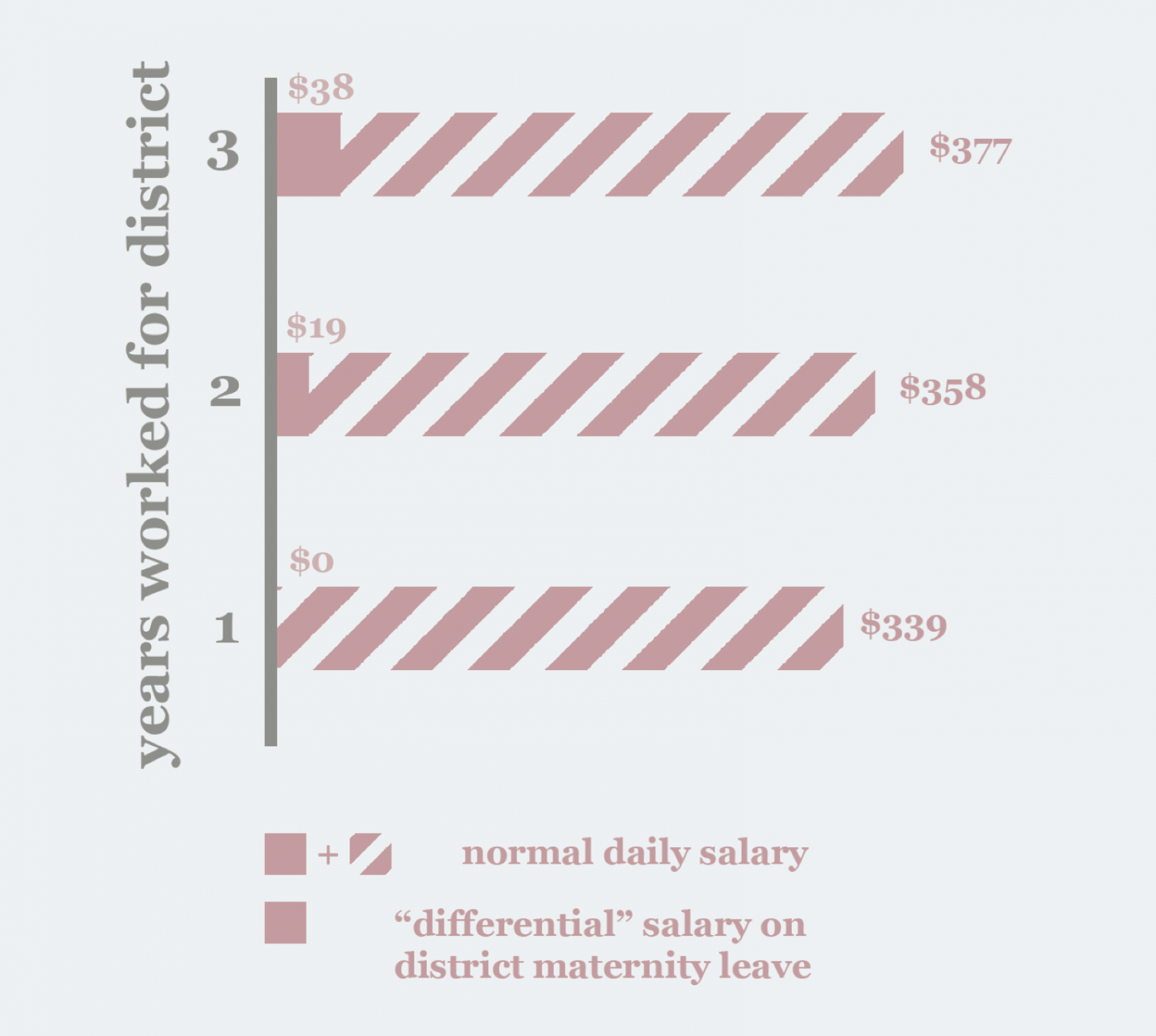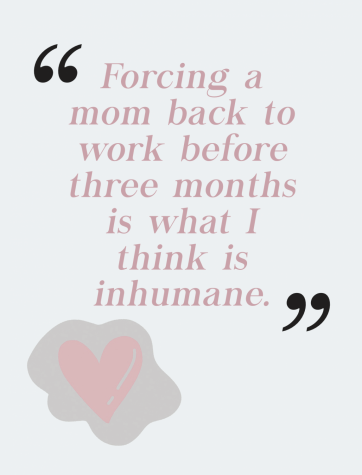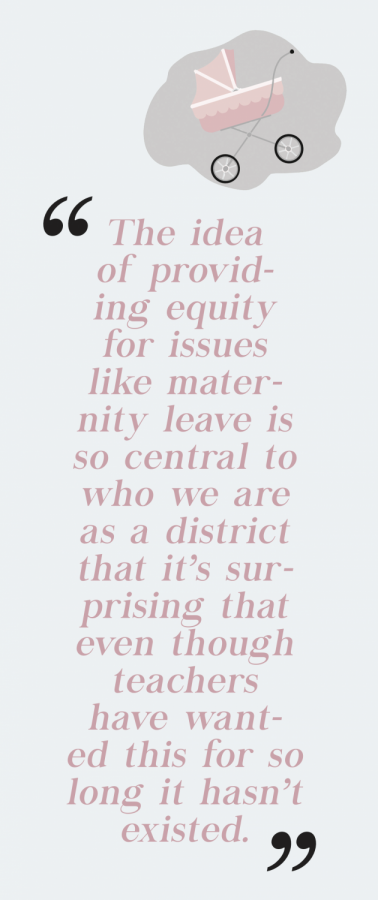Baby monitor
Let’s break down our district’s maternity leave policy and what it means for parents.
English teacher Abbey Levine sits on the floor of her classroom, rolling up large-scale, multicolored posters. Across the paper, words of Tam spirit are scrawled in big red and blue letters, courtesy of Link Crew. She smiles and slowly shifts her weight to stand while continuing to organize the posters. Levine is 25 weeks pregnant with her third child. Frustration lingers behind her voice when she speaks. The pace of her words becoming more rapid with every sentence. She’s anticipating maternity leave. It has been problematic in the past, both a confusing and financial burden.
Because of the pay gap between maternity and paternity leave, said Levine, it is almost definite the woman will be the one to take the most time off.
“I have a three-year-old and a five-year-old. If they see me home with the baby and dad going to work it would send a different message [than] if my husband was the one to take time off and stay home with the baby. It establishes what roles both parents play when raising a child,” Levine said. In countries around the world, women are not faced with the same difficulties that are in the U.S.
In Finland, expecting mothers receive 23 fully paid weeks of leave, and fathers receive eight. In Denmark, mothers receive a total of 52 full paid weeks of leave, 32 of which can be shared with her partner. Out of 196 countries, America is one of four that has no federally mandated policy to give new parents any paid maternity or paternity leave. The only federal law in place is the Family and Medical Leave Act, which guarantees mothers 12 weeks of unpaid leave, along with job security and healthcare for that period.
English teacher Amanda Spaht, who took maternity leave in 2018, believes that new parents nationwide should receive one year of fully paid maternity or paternity leave, which would “follow in the footsteps of other first world countries. Because as far as I’m concerned, we’re pretty behind those other countries.”
The Tamalpais Unified High School District’s (TUHSD) contract posted on the district website states that it “will be in compliance with the State Family Care and Medical Leave Act,” which is FMLA along with California’s law. The district does not provide additional requirements than what is required by state and federal laws are provided.
Before a new mother’s leave period begins, she is required by the district and state to utilize all of her sick days. The district allots new mothers something called Pregnancy Disability Leave (PDL) for the first part of her maternity leave. PDL can last up to 12 weeks, as determined by the mother’s physician. Throughout this time period, the mother receives differential pay. Differential pay means that the mother takes a pay cut equal to the substitute’s salary. This amount is considered the B-1 rate in the district, and is about $339.20 per day. The B-1 rate was agreed to in the district’s memorandum in the teacher contract, although it is unclear whether or not that memorandum was renewed. The available copy online states that it had expired in 2012, and Christensen reported that it was renewed. However, he did not provide evidence to support this claim.
For example, a teacher in their third year of working in the district makes around $377.15 pretax per day. If a new mother in this category takes leave, she will make $37.95 per day during the PDL period. A mother on leave in her second year working for the district would make about $19 a day. First year, a mother would be paid nothing during her disability leave period.

Substitute teachers can be paid different rates, however, which poses a complicated financial situation for the district. If the long-term substitute is a teacher in the district, or a former district teacher, they will be given their typical pay. The mother will still have the B-1 rate taken out of her paycheck, but the district pays for the difference between the substitute’s salary and the B-1 rate.
“It runs both ways to keep it even. If a teacher gets more money, they’ll get what they deserve,” said Lars Christensen, who works for Human Resources in the district and negotiates on behalf of the TUHSD board of trustees.
If the substitute is what is called an emergency substitute, which is the kind that stepped in for Spaht, they are paid less than the B-1 rate. Because the new mother will still receive their pay minus the B-1 rate, and the substitute is compensated less than that, the district saves money in these situations.
Laura Keaton, the administrative assistant to principal J.C. Farr, explained that the majority of long-term substitutes are paid the B-1 rate. It is very rare for the district to hire a substitute who makes more than that. Keaton further explained that although emergency substitutes, like Spaht’s replacement, are also uncommon, they are more frequent than the costly ones.
“If it really is the case that the district sometimes makes money off the substitute replacing the mother, then that’s horrendous. We need more consistency with the substitutes who are looking after the students,” special education teacher and wrestling coach Preston Picus said.

Following the disability leave, a mother goes on Parental Bonding Leave (PBL), as described by a state law that was updated in January 2019. Before January, mothers were granted differential pay of their salary minus the substitute’s rate for a period of 60 workdays, which is typically 12 weeks. Now, the mother receives 50 percent of her salary during this time.
California does have an opportunity for teachers to receive more money during their leave, an option referred to as Paid Family Leave (PFL). The state provides benefits of 60 to 70 percent, depending on income, of a new mother’s wages for up to six weeks. Mothers need to apply to be granted PFL, and one of the qualifications is if the mother will lose money during her maternity leave. This act is currently not mentioned in the district’s contract, and Christensen does not know if teachers have taken PFL in the past. He said he was unfamiliar with the option as a whole, despite having heard about it before.
Christensen said, “I don’t have an answer. But that would be between the teacher. I would need to read that, but it’s not something we’ve had in our contract ever. I’d like to make a copy of that though.” He added that teachers may not know about PFL because it has never been part of the district’s “practices.”

On October 13, Governor Gavin Newsom vetoed Assembly Bill 500, which would have required school districts, charter schools, and community colleges to grant new mothers fully paid maternity leave for at least six weeks. Currently, if teachers would like greater benefits in any areas determined by the contract, they are required to speak to their union representative and have them bring it up in negotiations with the board. The vetoed state law would have removed that obstacle specifically for maternity leave.
Newsome explained in his veto statement, “Providing every Californian worker with paid family leave is a noble goal and a priority for my administration. However, this bill will likely result in annual costs of tens of millions of dollars that should be considered as part of local collective bargaining.”
A similar bill was vetoed by Governor Jerry Brown in October of 2017.
“The fact that this law reached the desk of another governor is [a] sign that this needs to be recognized as a priority,” Levine said. Moreover, she said, the act had the potential to encourage other states to follow suit.
“People don’t think change can be made unless someone else does it first. We’ve been looking at other countries as an example, but we need one of our own states to step up,” Levine said.
Despite the recent statewide setback, some public school districts in the Bay Area have taken leave benefits to the next level before the updated Parental Bonding Leave state law was announced in January.
The San Francisco Unified School District’s Summary of Benefits provides 100 days, or around 20 weeks of maternity leave at regular pay, minus the daily cost of a long-term substitute teacher. Substitutes’ salaries in San Francisco are less than in the TUHSD, so mothers in that district are typically paid more during their leave.
Similar to the TUHSD, a mother or father teaching in SF Unified is required to use all their sick days before their parental leave starts. However, unlike the TUHSD, San Francisco’s district has always offered paid paternity leave.
As of now, Tam’s paternity leave policy is complex and is complex, and district officials have expressed uncertainty over the details. In the past, the leave provided to fathers required them to use all of their accumulated sick days before going on 12 weeks of unpaid leave. In the current contract, there is no mention of paid leave for fathers. Looking at the laws in place today, there are no regulations that require any type of paid leave for males in California or nationwide. However, like mothers, fathers can apply for state-provided Paid Family Leave — although, as stated before, the district’s contract does not mention this option.
Although this is a beneficial option for mothers and fathers across the state, they are still required to use their accumulated sick days. This is a common aspect of leave throughout the public sectors across the U.S.
“I wish that we had the option to not use up our sick leave,” science teacher Grace Backer said. Backer took her maternity leave in early 2019. “I had saved up all these days over the years by not taking sick days unless I was really, really sick. Instead of having 40, now I have 10. And new moms and babies get sick easily and often,” she said.
The majority of people taking parental leave in the private sector do not give up their personal days. This difference in benefits of parental leave widens the overall financial divide between the workers in the public and private sectors.
In the private sector in the Bay Area, Facebook employees receive 16 weeks of paid maternity or paternity leave, while Twitter employees receive 20. Salesforce allots the primary caregiver 26 weeks of full pay, and the secondary caregiver 12. But these benefits have yet to reach the public sector.
“It shouldn’t matter that you happen to work in a particular industry or not. That doesn’t make you or your family any more valuable than somebody who works in a different industry. And your time with your children isn’t any more valuable just because you hold a certain position,” Spaht said.
Furthermore, the private sectors demonstrate significantly more generous paternity plans than the public sector. Researchers have shown that this is not only beneficial to the fathers, but to the mothers in the long run.
A recent study by Harvard found that the more parental leave the father has available, the more likely it is for the mother to come back to work full time rather than returning part time.
“I was prepared to use my hours from my [sick days] for the few days I was out. I didn’t necessarily love that I had to use these hours as I believe [fully paid] paternity, and more importantly, maternity leave should be offered within the district,” social studies teacher and new father Tim Morgan said. Morgan took his unpaid leave before the law was updated.
“I was actually surprised to find out that the district [did] not have full paid maternity or paternity leave. I do not know all the details on the why but I’m sure the district has their reasons. The first few months with a newborn are so important to be home with the family, as it is an amazing, yet sometimes difficult time,” Morgan said.
In response to teachers feeling as though they are not given what they deserved, Christensen said, “They’re getting what the teachers association and the district has agreed to give them. We’re certainly complying with federal and state law. We’re not keeping something from them. They’re getting what they’re entitled to. Some want more, and that’s OK.”
Social studies teacher Sharilyn Scharf, a negotiator on the teachers union, said that the final decision does indeed come down to the numbers. She explained that in situations like last year, when a districtwide financial crisis prompted the board to lay off teachers and negotiate a rollback of medical benefits, “trying to add something [to the budget] when everybody is going to be losing something is just going to be impossible.”
Teacher union president Ann Jaime, who was at the latest negotiation meeting with the board, said she was unable to comment on this issue. “[Maternity leave] is one of the topics that is a part of contract negotiations for this year. Contract negotiations are completely confidential until the union and the district have reached an agreement,” Jaime said.
Christensen explained that there is a new contract in the works, to be released following the negotiations on December 3 and January 17.
“What we’re trying to do with the new contract language — and I can’t talk about specifics because negotiations are privileged information until it’s printed for the public — is push away the fog and make it clear. But what we’re not gonna do in a contract is that we’re not going to fill the contract up with state regulations and government codes,” Christensen said. The contract will provide references to state and federal laws, but will not specifically outline the teachers’ rights that come with them.
Until the new contract has been written and agreed upon, a teacher going on maternity or paternity leave will “receive benefits per the contract and per state and federal law. We’re not denying anybody rights for maternity leave or benefits by any stretch,” Christensen said.
When considering this aspect, many teachers believe that just because it’s the law, does not mean it is morally correct.

Christensen added that, at this point, “the Teachers Association has not presented a formal proposal for changes to our existing leave policy.” In other words, the teachers union has not yet offered a solution.
“If select teachers feel that the leave package isn’t what they’d like it to be, they need to be speaking to their representatives,” Christensen said.
According to Picus, parental leave has been an ongoing issue for some time, and whether it is part of the discussion has to do with the priorities of the union and the way it negotiates with the school board.
Picus and Levine both said the representatives of the teachers union within the past two years have pledged to prioritize maternity and paternity leave, but the policy has not changed beyond the update to state law. “I’ve never seen a public declaration about this issue. But I know there are many people who hope it should be a forefront [for negotiation],” Levine said.
The majority of teachers have advocated for full paid maternity leave, alongside an improved paternity leave system. “I hope that our district considers adding fully paid maternity and paternity. I know that a lot of teachers would agree with that hope,” Morgan said.
When the district is “more financially flush,” Scharf said that she would like to offer leave benefits to newborn parents that match San Francisco Unified’s 100 days of leave.
On the other hand, Christensen pointed out that although San Francisco’s leave benefits may be “more robust,” the teachers there receive fewer medical benefits overall, and are paid less than those in the TUHSD.
“It’s a tradeoff. It’s all negotiated between the teachers. And it’s not always incumbent on the district to say we’re gonna give give give, that’s negotiated settlement. So if teachers want better leave benefits in general, they can negotiate that,” he said.
Members of the school district, such as superintendent Tara Taupier, believe that “the [parental] leave is supportive of new parents and is, from my understanding, more than many other districts do. As with anything, these issues are negotiated with our union and due to that, I am not going to make any further comment.”
However, many teachers, such as Spaht and Levine, argue that the leave policy is, in fact, not very supportive.

In the background of the parental leave debate is a proposed parcel tax, which, if passed next March, could pour an additional $6 million into the district and remove the risk of further debt in the near future. Moreover, it could potentially create a cleaner path for Scharf and the other negotiators to move forward with negotiations. As Christensen said, if the parcel tax passes, “then there will be money for negotiation.That’s up to the teachers association to bring forward a proposal.” Like many staff members in the district, he is hopeful the parcel tax will be placed on the ballot and passed.
“Although until that point, why ask when you know what the answer is going to be?” Scharf said.
District staff get paid on a scale based on how long they have been working, and must work 75 percent of the year to qualify for the next salary level. However, sick days can count towards completing work for this percentage of the year. But the only way to achieve the amount of days required, is if a mother has saved up enough sick days to qualify. In order to do this, she would need to save all of her sick days from the past few years leading up to her pregnancy.
The fact that new mothers do not rise up in salary the year they take leave due to the district’s system prevents new mothers from receiving higher salaries.
“I didn’t get to move up this year, so it’s as if I didn’t teach last year. If I’d come back for two weeks I would have made a lot more money this year,” Backer said.
Picus, who is Levine’s husband, has advocated for improved maternity leave for over two years.
“Women should get three months [fully paid leave] minimum. Forcing a mom back to work before three months is what I think is inhumane,” he said.
Picus explained that according to his calculations, it would be “relatively inexpensive to offer all women three months of paid leave.” In 2018, he drafted an email outlining his proposal to district staff and the board.

“Three months of paid leave for a teacher who is having a baby seems to me a very standard offering that the district could burden,” Picus wrote in the email, which ended up unsent. “I’m not exactly sure of the number of teachers who have children each year … If we say that there are 15 each year, and they each are allowed three months of paid leave, the total cost to the district would be about $315,000. That number could be significantly lower, as the district might be able to hire a substitute at a rate which is less than the B-1 rate which the teacher is currently charged.”
In regards to Picus’ argument, Scharf said that while maternity leave is not a huge expense, “it is a significant ongoing expense that they would have to budget for. And if they’re going to pay for that, something else is going to have to go.”
Parental leave is a complex issue, and a hot-button one at that. It doesn’t seem to have a resolution in the near future.
“Our district is very progressive in terms of the ideas we teach our students. The fact that we discuss civil rights the way that we do and women’s rights the way that we do … demonstrates this,” Levine said. “The idea of providing equity for issues like maternity leave is so central to who we are as a district that it’s surprising that even though teachers have wanted this for so long it hasn’t existed.”
Mikyla Williams contributed additional reporting.


